The church that is no longer there
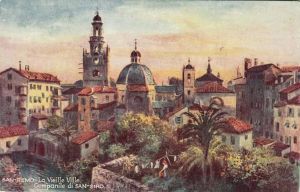 "In April 1636, while the people of San Remo were waiting to enlarge the Oratory of San Germano, and dig its foundations, great remains of ancient buildings came to light, with objects of antiquity and a large number of silver and copper coins, most of which bore the imprint of the emperors Claudius and Flavio Vespasiano. These coins were religiously kept in a bag by the Prior of the Oratory, it as a sacred deposit transmitted them to the new elected, when he left office. In this way they were able to cross about two centuries, where they passed today".
"In April 1636, while the people of San Remo were waiting to enlarge the Oratory of San Germano, and dig its foundations, great remains of ancient buildings came to light, with objects of antiquity and a large number of silver and copper coins, most of which bore the imprint of the emperors Claudius and Flavio Vespasiano. These coins were religiously kept in a bag by the Prior of the Oratory, it as a sacred deposit transmitted them to the new elected, when he left office. In this way they were able to cross about two centuries, where they passed today".
(cf. Girolamo Rossi - History of Sanremo - pg. 72.73)
Speaking of the church of San Siro it has been said that the area of the "Piano" in imperial times was very frequented and inhabited. In the 1st century A.D., there were therefore magnificent buildings that came to light about 1500 years later while the foundations of the perimeter walls of the Oratory of San Germano were being built. This church, was the 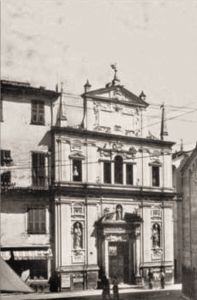 northernmost building of the architectural complex that formed the square dominated by the Basilica.
northernmost building of the architectural complex that formed the square dominated by the Basilica.
Unfortunately there are no photographs of the interiors of the ancient oratory, only the exteriors have photographic reproductions that show us the beautiful architecture of the baroque façade of the second half of the seventeenth century, attributed to the architect Pellegrino Tibaldi; façade with varied profiles, coloured mirrors, the particular Serlian window in the centre and the ornamental spires on the sides, which contributed to make the structure even more slender.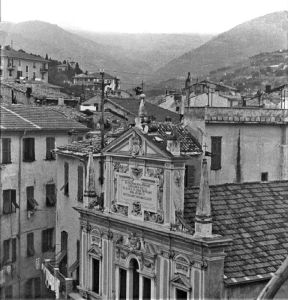 The square with four churches seemed to be a scenography created for an opera performance, so much so that in the 1930s, when Pietro Mascagni was at home in Sanremo and in the Casino Opera House, he set his Cavalleria rusticana in this very square.
The square with four churches seemed to be a scenography created for an opera performance, so much so that in the 1930s, when Pietro Mascagni was at home in Sanremo and in the Casino Opera House, he set his Cavalleria rusticana in this very square.
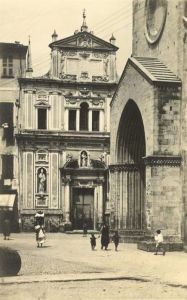 The oratory followed the classic scheme of the confraternity building, with a single nave, with benches along the walls arranged to welcome the brethren. In June 1753 the Parliament of the Civitas Sancti Romuli met here during the revolution against Genoa; during this meeting, convened at the ringing of the bell, it was decided to ask for the annexation of Sanremo to the Kingdom of Sardinia, a decision that was never followed because of the immediate and resolute reaction of the Genoese.
The oratory followed the classic scheme of the confraternity building, with a single nave, with benches along the walls arranged to welcome the brethren. In June 1753 the Parliament of the Civitas Sancti Romuli met here during the revolution against Genoa; during this meeting, convened at the ringing of the bell, it was decided to ask for the annexation of Sanremo to the Kingdom of Sardinia, a decision that was never followed because of the immediate and resolute reaction of the Genoese.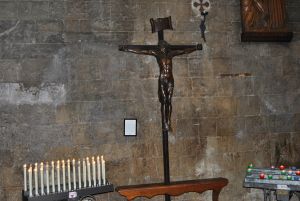
Of the interior furnishings there are the large paintings with scenes from the life of St. Germano, still on display in the Baptistery and the ancient wooden "Black Christ" of the Confraternity, currently displayed in the Basilica on the right side wall. The beautiful 19th century statue of St. Germano, also kept in the Baptistery, has been transformed by the local painter and historian Carlo Alberto into the statue of the patron saint Romulus with the addition of the civic coat of arms and a wooden sword.
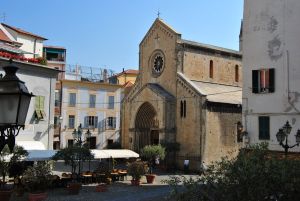
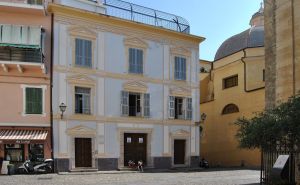 Despite the slight amount of war damage, it was decided to demolish the church to allow it to be transformed into the "Parish Works of St. Pius X", a complex which was inaugurated and blessed by Bishop Mons. Agostino Ruosset on 30th June 1957.
Despite the slight amount of war damage, it was decided to demolish the church to allow it to be transformed into the "Parish Works of St. Pius X", a complex which was inaugurated and blessed by Bishop Mons. Agostino Ruosset on 30th June 1957.
A small note in the margin: the parish priest of the time, Mons. Pasquale Oddo, recounted with regret and regret how he was forced by the guardians to demolish the beautiful façade because they absolutely did not want any trace of the ancient building to remain.
 In fact he had proposed a solution that provided for the preservation of the ancient façade and the use of the interior of the Oratory for the construction of the spaces necessary for the construction of a theatre, meeting rooms and a flat for a priest.
In fact he had proposed a solution that provided for the preservation of the ancient façade and the use of the interior of the Oratory for the construction of the spaces necessary for the construction of a theatre, meeting rooms and a flat for a priest.
It was not possible and so today we cannot enjoy the view of an almost unique view of four churches overlooking the same square.
There were a series of rooms bordering the main building of the Oratory that were in use at the Confraternity, whose entrance can still be seen today, in a small door at the beginning of via Debenedetti. Entrance with a marble door above representing the titular Saint and the date engraved 1708 with the letters S. G. per San Germano.
(text source: Ernesto Porri; image sources: private archive)




